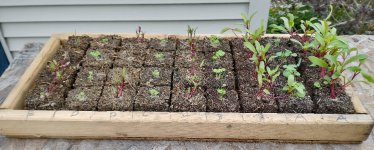The last photo was taken on Monday and the attached photo to this post is taken on Friday of the same week.
The difference between the peat and coconut coir verses those with sawdust mixed in is clear.
From this I will continue to use the peat bale I have until it has been consumed then move to using coir.
@Chuck - you mentioned greensand in your mix and I expanded it to rockdust generally. Is greensand, greensand, greensand? That is, are there good brands / sources and bad copies of them or do I just get the first one I find? I know some people evangelize rock dust. Is rockdust interchangeable with greensand?
@DirtMechanic - the betadine solution. Is that used both as a tool disenfectant and a spray / drench on the seedlings or just spray contact killer? I know damping off is a soilborne fungi and is endemic around my place.
I will have another experiment in the future. I am thinking it will include greensand and corn meal but I think the betadine trails will be purely reactive and not planned.





